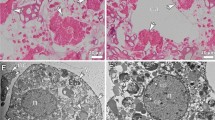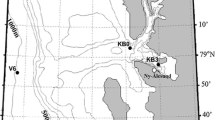Abstract
FemaleEuchaeta marina (Prestandrea, 1833) have one large, thin-walled lipid sac, whereas femalePleuromamma xiphias (Giesbrecht, 1889) have two separate and morphologically distinct lipid storage sites. One lipid site inP. xiphias corresponds to the mesenteric tissue that surrounds the anterior region of the midgut. The morphology of these cells resembles that of mammalian brown adipocytes. The cytoplasm is filled with extensive smooth endoplasmic reticulum, numerous mitochondria and several deposits of intracellular lipid. The second lipid site ofP. xiphias lies in the posterior region of the metasome and resembles the thin-walled lipid sac ofE. marina. Both lie adjacent to, but are not contiguous with, the narrow mesenteric tissue surrounding the last region of the midgut. Both sacs contain a single, large deposit of intracellular lipid enclosed by a very thin rim of cytoplasm and resemble mammalian white adipocytes. The different habitats and reproductive processes of these two copepod species may relate to the observed variations in lipid cell morphology. The reserve lipid inE. marina plays a primary role in reproduction and is linked closely with the continuous cycle of oocytic maturation. The lipids synthesized and stored byP. xiphias, a strong vertical migrator, may be influenced by food availability, a function of their mesopelagic habitat. The primary role of the reserve lipids in this copepod may be to provide energy during migrations and between feeding periods, with relatively less lipid being allocated to reproduction.
Similar content being viewed by others
Literature cited
Arnaud, J., Brunet, J. M., Mazza, J. (1978). Studies on the midgut ofCentropages typicus (copepod, calanoid). Cell Tissue Res. 187: 333–353
Bauermeister, A. E. M., Sargent, J. R. (1979). Wax esters: major metabolites in the marine environment. Trends biochem. Sciences 4: 209–211
Benson, A. A., Lee, R. F., Nevenzel, J. C. (1972). Wax esters: major marine metabolic energy sources. Biochem. Soc. Symp. 35: 175–187
Bradford, J. M. (1974).Euchaeta marina (Prestandrea) (Copepoda, Calanoida) and two closely related new species from the Pacific. Pacif. Sci. 28: 159–169
Buskey, E. J., Baker, K. S., Smith, R. C., Swift, E. (1989). Photosensitivity of the oceanic copepodsPleuromamma gracilis andPleuromamma xiphias and its relationship to light penetration and daytime depth distribution. Mar. Ecol. Prog. Ser. 55: 207–216
Claus, C. (1863). Die freilebenden Copepoden mit besonderer Berücksichtigung der Fauna Deutschlands, der Nordsee und des Mittelmeeres. Engelmann, Leipzig
Fawcett, D. (1986). Adipose tissue. Chapter 6. In: Fawcett, D. W. (ed.) A textbook of histology. W. B. Saunders Co., London, p. 174–187
Gatten, R. R., Sargent, J. R. (1973). Wax ester biosynthesis in calanoid copepods in relation to vertical migration. Neth. J. Sea Res. 7: 150–158
Giesbrecht, W. (1889). Elenco dei copepodi pelagici raccolti dal tenente di vascello Gaetano Chierchia durante il viaggio della R. Corvetta “Vettor Pisani” negli anni 1882–1885 e del di vascello Francesco Orsini nel Mar Rosso, nel 1884. Atti Rendiconti della Roma Academia dei Lincei, series 4. 5(2): 24–29. [Cited after Ferrari, F. D. (1985). Smithson. Contr. Zool. 420: 1–55]
Hakanson, J. L. (1984). The long and short term feeding condition in field-caughtCalanus pacificus, as determined from the lipid content. Limnol. Oceanogr. 29: 794–804
Haury, L. R. (1988). Vertical distribution ofPleuromamma (Copepoda: Metridinidae) across the eastern North Pacific Ocean. Hydrobiologia 167/168: 335–342
Henderson, R. J., Sargent, J. R. (1980). Biosynthesis of neutral lipids byEuchaeta norvegica. Mar. Biol. 56: 1–6
Karnovsky, M. J. (1965). A formaldehyde-glutaraldehyde fixative of high osmolarity for use in electron microscopy. J. Cell Biol. 27: p. 137A
Lee, R. F. (1974). Lipid composition of the copepodCalanus hyperboreus from the Arctic Ocean. Changes with depth and season. Mar. Biol. 26: 313–318
Lee, R. F., Barnes, R. T. (1975). Lipids in the mesopelagic copepod,Gaussia princeps. Wax ester utilization during starvation. Comp. Biochem. Physiol. 52B: 265–268
Lee, R. F., Hirota, J. (1973). Wax esters in tropical zooplankton and nekton and the geographical distribution of wax esters in marine copepods. Limnol. Oceanogr. 18: 227–239
Lee, R. F., Hirota, J., Barnett, A. M. (1971). Distribution and importance of wax esters in marine copepods and other zooplankton. Deep-Sea Res. 18: 1147–1165
Lee, R. F., Nevenzel, J. C., Lewis, A. G. (1974). Lipid changes during the life cycle of marine copepod,Euchaeta japonica Marukawa. Lipids 9: 891–898
Lowe, E. (1935). On the anatomy of a marine copepod,Calanus finmarchicus (Gunnerus). Trans. R. Soc. Edinb. 58: 561–603
Marshall, S. M., Orr, A. P. (1955). The biology of a marine copepod,Calanus finmarchicus (Gunnerus). Oliver & Boyd, Edinburgh and London
Park, T. (1975). Calanoid copepods of the family Euchaetidae from the Gulf of Mexico and western Caribbean Sea. Smithson. Contr. Zool. 196: 1–26
Petipa, T. S. (1964). The diurnal rhythm of the consumption and accumulation of fat inCalanus finmarchicus (Claus) in the Black Sea. Dokl. Acad. Nauk armyan. SSR 156: 361–364
Prestandrea, N. (1833). Su di alcuni nuovi crostacei del Mare di Messina. Effemeridi Scient. Letterarie Sicilia. 6: 3–14. [Cited after Park, T. (1978). Antarctic Res. Ser. 27: 91–290]
Reger, J. F., Frase, S., Tso, P. (1989). Fine structure observations on rat jejunal epithelial cells during fat processing and resorption following L-81 exposure and reversal. J. submicrosc. Cytol. Path. 21: 399–408
Richardson, K. C., Jarett, L., Finke, E. H. (1960). Embedding in epoxy resins for ultrathin sectioning in electron microscopy. Stain Technol. 335: 313–323
Sargent, J. R., Falk-Petersen, S. (1988). The lipid biochemistry of calanoid copepods. Hydrobiologia 167/168: 101–114
Sargent, J. R., Henderson, R. J. (1986). Lipids. In: Corner, E. D. S., O'Hara, S. C. M. (eds.) The biological chemistry of marine copepods. Clarendon Press, Oxford, p. 59–108
Slavin, B. G. (1987). The ultrastructure of adipocytes. In: Hausman, G. J., Martin, R. (eds.) The biology of the adipocyte. Research approaches. Van Nostrand Reinhold Co. Inc., New York, p. 52–85
Williamson, J. R. (1964). Adipose tissue. Morphological changes associated with lipid metabolism. J. Cell Biol. 20: 57–74
Author information
Authors and Affiliations
Additional information
Communicated by J. M. Lawrence, Tampa
Rights and permissions
About this article
Cite this article
Blades-Eckelbarger, P.I. Comparative ultrastructure of lipid storage sites in femaleEuchaeta marina andPleuromamma xiphias (Copepoda: Calanoida). Mar. Biol. 108, 49–58 (1991). https://doi.org/10.1007/BF01313470
Accepted:
Issue Date:
DOI: https://doi.org/10.1007/BF01313470




